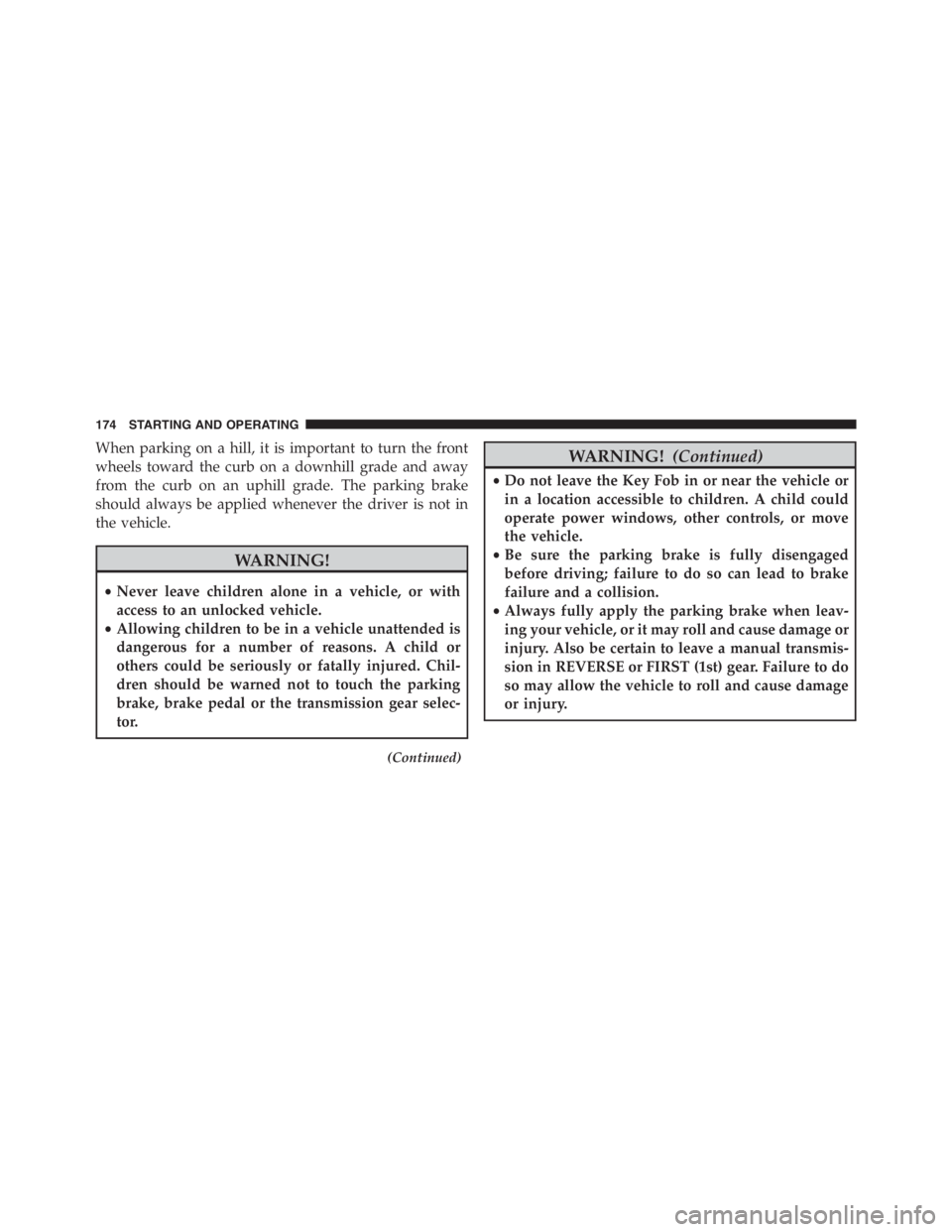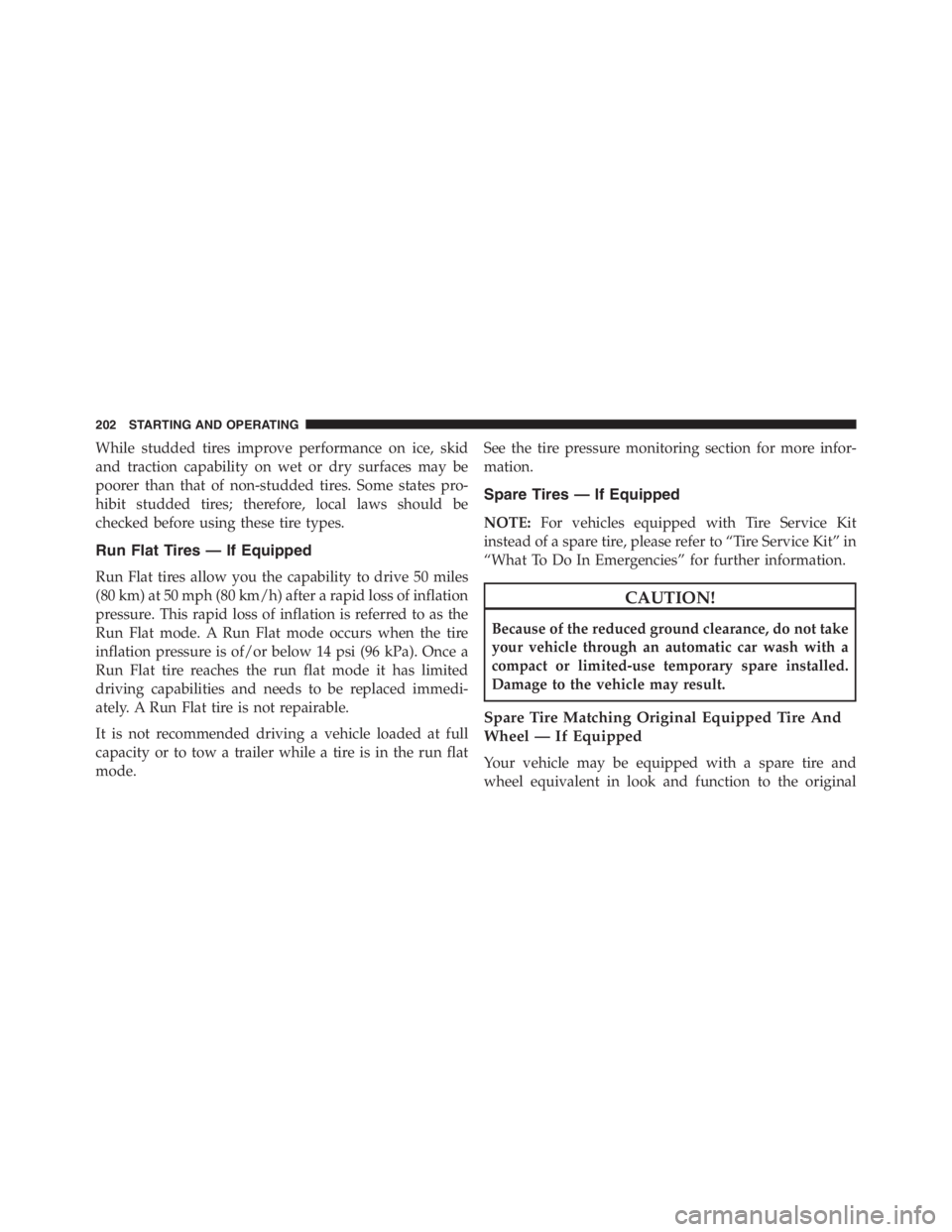Page 155 of 348

▫Tire Types...........................200
▫Run Flat Tires — If Equipped.............202
▫Spare Tires — If Equipped...............202
▫Tire Spinning........................205
▫Tread Wear Indicators..................205
▫Life Of Tire.........................206
▫Replacement Tires.....................206
�TIRE CHAINS (TRACTION DEVICES).......208
�TIRE ROTATION RECOMMENDATIONS.....209
�TIRE PRESSURE MONITORING SYSTEM
(TPMS)..............................210
▫Base System.........................212
▫General Information...................215�FUEL REQUIREMENTS — 1.750 Turbo.......215
▫Reformulated Gasoline.................216
▫Gasoline/Oxygenate Blends..............216
▫MMT In Gasoline.....................216
▫Materials Added To Fuel................217
▫Fuel System Cautions...................217
▫Carbon Monoxide Warnings.............218
�ADDING FUEL/SMART FUEL.............219
�TRAILER TOWING.....................222
�RECREATIONAL TOWING (BEHIND
MOTORHOME, ETC.)...................222
▫Towing This Vehicle Behind Another Vehicle . .222
5
STARTING AND OPERATING 153
Page 158 of 348

CAUTION!
•Do not attempt to push or tow your vehicle to get it
started. Vehicles equipped with a Alfa Twin Clutch
Transmission cannot be started this way. Unburned
fuel could enter the catalytic converter and once the
engine has started, ignite and damage the converter
and vehicle.
•To prevent damage to the starter, do not continu-
ously crank the engine for more than 15 seconds at
a time. Wait 10 to 15 seconds before trying again.
After Starting
The idle speed is controlled automatically and it will
decrease as the engine warms up.
Turbo Charger “Cool Down”
This vehicle is equipped with an after-run pump to cool
the turbocharger after the engine is shut off. Dependingon the type of driving and the amount of cargo, the pump
will run for up to five minutes after the engine has been
shut off to circulate coolant through the turbocharger.
Although the pump is rubber-mounted for quiet opera-
tion, it is normal to hear it running during this time.
SIX-SPEED ALFA TWIN CLUTCH TRANSMISSION
WARNING!
•It is dangerous to shift out of NEUTRAL if the
engine speed is higher than idle speed. If your foot
is not firmly pressing the brake pedal, the vehicle
could accelerate quickly forward or in reverse. You
could lose control of the vehicle and hit someone or
something. Only shift into gear when the engine is
idling normally and your foot is firmly pressing
the brake pedal.
(Continued)
156 STARTING AND OPERATING
Page 164 of 348

control panel (it is not necessary to press the brake pedal)
the transmission will immediately engage the correct
gear according to the car ’s speed.
If the vehicle is stationary with the engine running and
FIRST (1st) gear or REVERSE (R) engaged, the system
activates an acoustic signal and automatically places the
transmission in NEUTRAL (N) when:
The accelerator and/or brake pedal are not operated for
at least three minutes.
The brake pedal is pressed for longer than 10 minutes.
The driver ’s door is opened and the accelerator pedal or
the brake pedal are not operated for at least one and a
half seconds.
A fault has been detected in the transmission.Parking The Vehicle
When parking and leaving the car, proceed as follows:
1. Press the brake pedal and shift the transmission into
First (1st).
2. Stop the engine and firmly engage the parking brake.
3. Release the brake pedal.
When parking on an incline, turn the front wheels toward
the curb on a downhill slope and away from the curb on
an uphill slope. Always chock the wheels when parking
on steep grades.
General Notes
When the vehicle is stopped and in gear, always keep the
brake pedal pressed until you decide to set off, then
release the brake and accelerate gradually.
162 STARTING AND OPERATING
Page 176 of 348

When parking on a hill, it is important to turn the front
wheels toward the curb on a downhill grade and away
from the curb on an uphill grade. The parking brake
should always be applied whenever the driver is not in
the vehicle.
WARNING!
•Never leave children alone in a vehicle, or with
access to an unlocked vehicle.
•Allowing children to be in a vehicle unattended is
dangerous for a number of reasons. A child or
others could be seriously or fatally injured. Chil-
dren should be warned not to touch the parking
brake, brake pedal or the transmission gear selec-
tor.
(Continued)
WARNING!(Continued)
•Do not leave the Key Fob in or near the vehicle or
in a location accessible to children. A child could
operate power windows, other controls, or move
the vehicle.
•Be sure the parking brake is fully disengaged
before driving; failure to do so can lead to brake
failure and a collision.
•Always fully apply the parking brake when leav-
ing your vehicle, or it may roll and cause damage or
injury. Also be certain to leave a manual transmis-
sion in REVERSE or FIRST (1st) gear. Failure to do
so may allow the vehicle to roll and cause damage
or injury.
174 STARTING AND OPERATING
Page 195 of 348
NOTE:Under a maximum loaded vehicle condition,
gross axle weight ratings (GAWRs) for the front and rear
axles must not be exceeded. For further information on
GAWRs, vehicle loading, and trailer towing, refer to
“Vehicle Loading” in this section.
To determine the maximum loading conditions of your
vehicle, locate the statement “The combined weight of
occupants and cargo should never exceed XXX lbs or
XXX kg” on the Tire and Loading Information placard.
The combined weight of occupants, cargo/luggage and
trailer tongue weight (if applicable) should never exceed
the weight referenced here.Steps For Determining Correct Load Limit
1. Locate the statement “The combined weight of occu-
pants and cargo should never exceed XXX lbs or
XXX kg” on your vehicle’s placard.
2. Determine the combined weight of the driver and
passengers that will be riding in your vehicle.
3. Subtract the combined weight of the driver and pas-
sengers from XXX lbs or XXX kg.
5
STARTING AND OPERATING 193
Page 196 of 348

4. The resulting figure equals the available amount of
cargo and luggage load capacity. For example, if
“XXX” amount equals 1,400 lbs (635 kg) and there will
be five 150 lb (68 kg) passengers in your vehicle, the
amount of available cargo and luggage load capacity
is 650 lbs (295 kg) (since 5 x 150 lbs (68 kg) = 750 lbs
(340 kg), and 1400 lbs (635 kg) – 750 lbs (340 kg) =
650 lbs [295 kg]).
5. Determine the combined weight of luggage and cargo
being loaded on the vehicle. That weight may not
safely exceed the available cargo and luggage load
capacity calculated in step 4.NOTE:
•If your vehicle will be towing a trailer, load from your
trailer will be transferred to your vehicle. The follow-
ing table shows examples on how to calculate total
load, cargo/luggage, and towing capacities of your
vehicle with varying seating configurations and num-
ber and size of occupants. This table is for illustration
purposes only and may not be accurate for the seating
and load carry capacity of your vehicle.
•For the following example, the combined weight of
occupants and cargo should never exceed 865 lbs
(392 kg).
194 STARTING AND OPERATING
Page 204 of 348

While studded tires improve performance on ice, skid
and traction capability on wet or dry surfaces may be
poorer than that of non-studded tires. Some states pro-
hibit studded tires; therefore, local laws should be
checked before using these tire types.
Run Flat Tires — If Equipped
Run Flat tires allow you the capability to drive 50 miles
(80 km) at 50 mph (80 km/h) after a rapid loss of inflation
pressure. This rapid loss of inflation is referred to as the
Run Flat mode. A Run Flat mode occurs when the tire
inflation pressure is of/or below 14 psi (96 kPa). Once a
Run Flat tire reaches the run flat mode it has limited
driving capabilities and needs to be replaced immedi-
ately. A Run Flat tire is not repairable.
It is not recommended driving a vehicle loaded at full
capacity or to tow a trailer while a tire is in the run flat
mode.See the tire pressure monitoring section for more infor-
mation.
Spare Tires — If Equipped
NOTE:For vehicles equipped with Tire Service Kit
instead of a spare tire, please refer to “Tire Service Kit” in
“What To Do In Emergencies” for further information.
CAUTION!
Because of the reduced ground clearance, do not take
your vehicle through an automatic car wash with a
compact or limited-use temporary spare installed.
Damage to the vehicle may result.
Spare Tire Matching Original Equipped Tire And
Wheel — If Equipped
Your vehicle may be equipped with a spare tire and
wheel equivalent in look and function to the original
202 STARTING AND OPERATING
Page 221 of 348
WARNING!(Continued)
•Guard against carbon monoxide with proper main-
tenance. Have the exhaust system inspected every
time the vehicle is raised. Have any abnormal
conditions repaired promptly. Until repaired, drive
with all side windows fully open.
ADDING FUEL/SMART FUEL
NOTE:
•The�Smart Fuel�is a device placed on the top of the
filler pipe, it opens and closes automatically when the
fuel nozzle is inserted or extracted.
•Only the correct nozzle size diameter allows the flap
door to open when the nozzle is inserted.Refueling Procedure
1. Open the fuel filler door pulling towards outside.
2. There is no fuel filler cap. A flap door inside the pipe
seals the system.
Fuel Filler Door Location
5
STARTING AND OPERATING 219